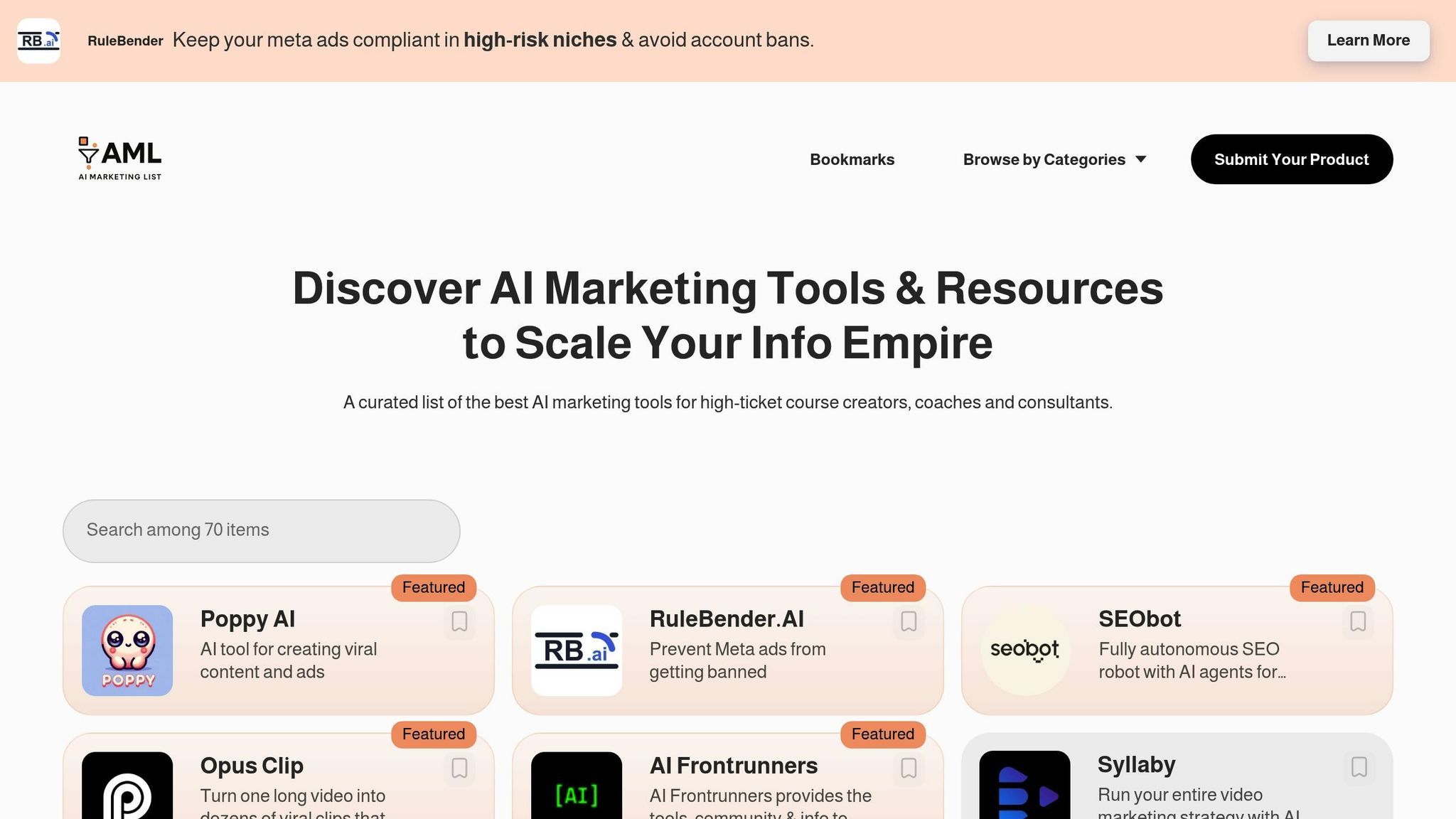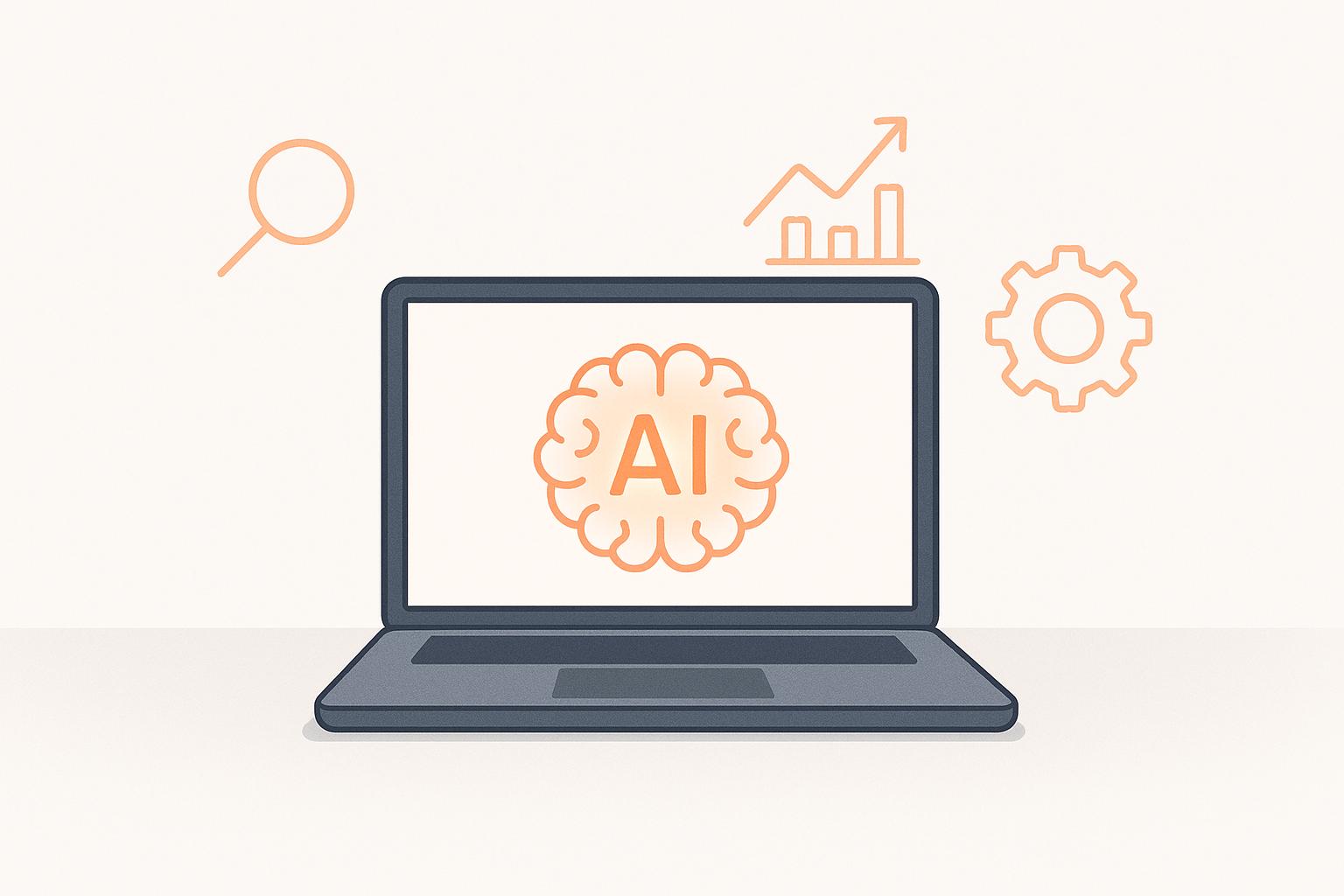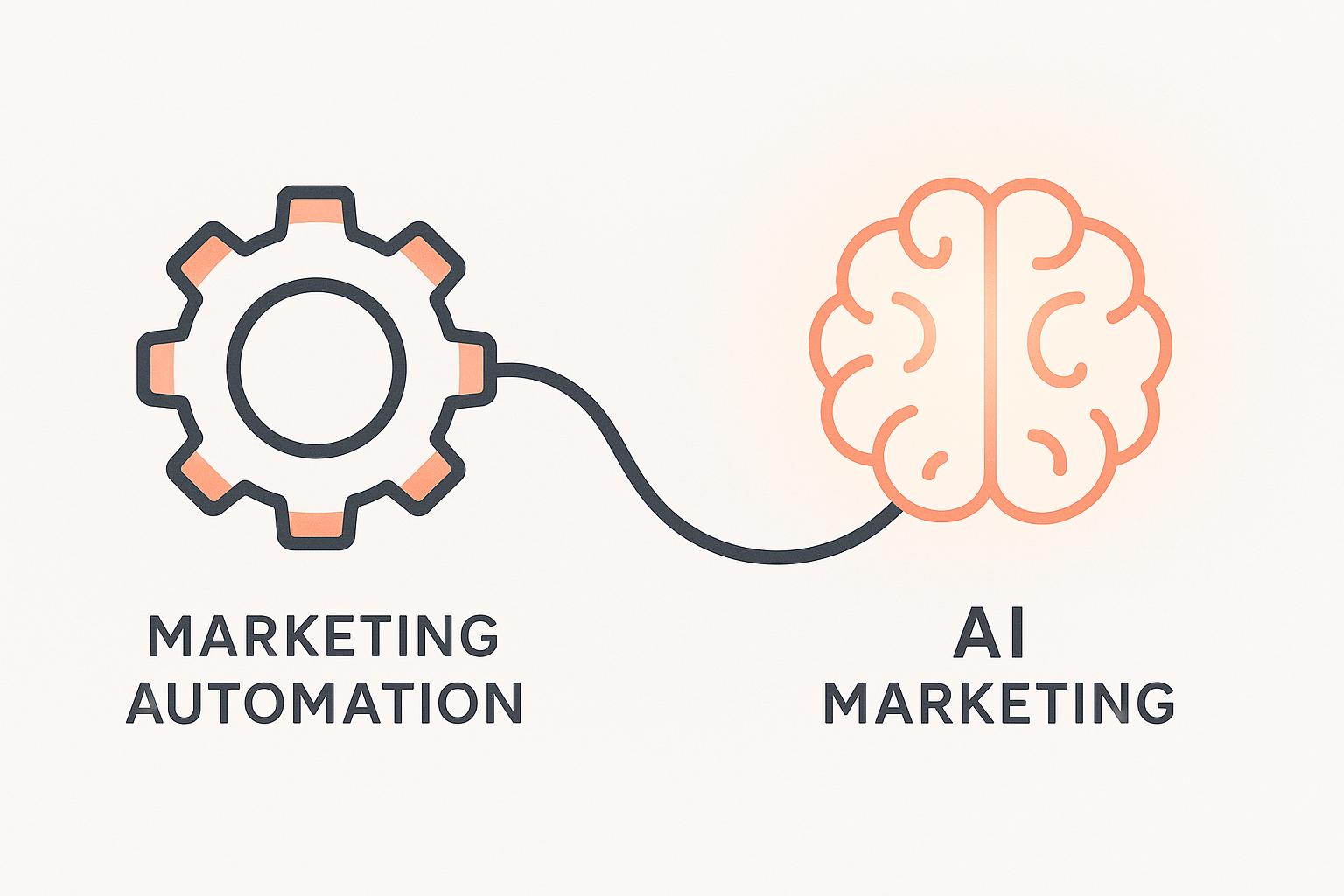AI tools for social media are reshaping how businesses create, manage, and analyze content. These tools automate tasks like writing captions, designing visuals, and analyzing performance, helping businesses save time and cut costs by up to 50%. With 61% of U.S. marketers already using AI tools and 92% planning to increase investments, these solutions are essential for staying competitive in 2025.
Key Takeaways:
- What They Do: AI tools handle text, visuals, and strategy, including captions, graphics, and audience analysis.
- Benefits: Save time, reduce costs, improve engagement, and deliver personalized content.
- Popular Tools: Jasper, Buffer, Canva AI, Hootsuite, and more, each offering unique features at various price points.
- How They Work: Leverage machine learning, NLP, and generative AI to create and optimize content.
- Choosing the Right Tool: Focus on features, pricing, platform integration, and ease of use. Test tools through free trials to find the best fit.
AI-powered tools are transforming social media workflows, making it easier to produce engaging content while improving efficiency.
Top 10 AI Tools for Social Media in 2025
How AI Social Media Content Tools Work
This section dives into the mechanics of AI-powered tools, explaining how they simplify and enhance content creation. By understanding how these tools operate, businesses can make better choices about which technologies align with their goals. These tools leverage cutting-edge technologies to create, refine, and distribute content across various platforms, laying the groundwork for more effective social media strategies.
The Technology Behind AI Tools
AI social media tools are powered by machine learning (ML), natural language processing (NLP), and generative AI. Here's how these technologies work together:
- Machine Learning (ML): ML identifies patterns in data to automate tasks and provide tailored recommendations, making content creation smarter and faster.
- Natural Language Processing (NLP): NLP allows tools to interpret and generate human-like text, whether it’s crafting captions that reflect a brand’s tone or replying to comments in a conversational style.
- Generative AI: Using deep learning and neural networks, including GANs (Generative Adversarial Networks), generative AI creates realistic and engaging content from existing data.
Interestingly, 80% of top-performing organizations are already using generative AI. For businesses new to this technology, experts recommend starting with a specific focus - like image creation or text-based content - before branching out into other areas. Knowing these technical foundations can help you choose the right tool for your social media needs.
Common Workflows for Content Creation
AI social media tools typically follow a clear workflow to streamline content creation:
- Planning: These tools analyze audience behavior and current trends to guide content strategies.
- Content Creation: Tools generate posts, visuals, and even A/B test variations to find what resonates best with your audience.
- Platform-Specific Optimization: Whether it’s resizing images for Instagram Stories, crafting professional posts for LinkedIn, or creating snappy TikTok videos, these tools fine-tune content for each platform.
- Scheduling and Publishing: Posts are scheduled to go live at optimal times for maximum engagement.
- Performance Tracking: Analytics track metrics like clicks, engagement rates, and conversions, providing insights to refine future strategies.
This structured approach ensures consistency and efficiency while adapting to the unique requirements of different platforms.
Integrations with Social Media Platforms
AI tools are built to work seamlessly with major platforms like Facebook, Instagram, LinkedIn, TikTok, and X (formerly Twitter). These integrations let you handle tasks such as scheduling, automated posting, and responding to comments - all from a single dashboard. Many tools also connect with platforms like Telegram, Pinterest, Tumblr, and WordPress, giving businesses access to a broader audience.
Here’s a quick look at pricing for popular tools:
- Buffer Essentials: Starts at $5 per channel/month
- Publer Professional: Starts at $4 per channel/month
- ContentStudio Standard: $19 per month for 5 accounts
- Hootsuite Enterprise: Starts at $149 per user/month
When choosing a tool, it’s crucial to ensure it integrates smoothly with your existing social media platforms and marketing tools. With users spending an average of 2 hours and 21 minutes daily on social media, having robust integrations can help you capture attention during those peak moments of engagement.
Top AI Social Media Content Tools for 2025
AI tools have become a must-have for U.S. businesses looking to streamline their social media content. With over 80% of content recommendations now powered by AI and predictions suggesting that by 2025, 90% of online content will be AI-generated, picking the right tool is more important than ever to stay ahead.
Comparison of Leading Tools
| Tool Name | Best For | Features | Pricing (USD) | Limitations |
|---|---|---|---|---|
| Jasper | AI Writing Assistant | AI writing, templates, marketing copy | $49/month | Can get pricey with advanced usage |
| Buffer | Multichannel campaign management | Scheduling, analytics | $5/month/channel | Cost increases with more channels |
| Predis.ai | Generating carousels and videos | Competitive analysis, post copy, designs | $27/month | Interface may lack polish |
| Canva AI | Graphic Design | Design automation, templates, Magic Write | $12.99/month | Not ideal for advanced designers |
| Hootsuite | Enterprise social management | Templates, analytics | $149/user/month | Expensive for small businesses |
| ContentStudio | Content topic management | Automation, AI generation | $19/month | Interface takes time to learn |
| HubSpot AI | CRM and Marketing Automation | Lead scoring, content optimization | $50/month | Steep learning curve for beginners |
| Publer | Text and image generation | Text-to-image AI, scheduling | $4/month/channel | Limited integrations outside social |
Here’s a closer look at what makes these tools stand out.
Overview of Popular Tools
Jasper is a go-to for marketers needing high-quality AI-generated copy tailored for social platforms. Its extensive templates make it versatile for various content needs.
Buffer is a favorite among small and medium-sized businesses. Starting at $5 per month per channel, it offers tailored post scheduling and optimization for tone, length, and platform formatting. Plus, there’s a free plan for up to three channels.
Predis.ai acts like a mini content team. For $27 a month, it delivers post copy, designs, and even hashtag suggestions. It’s especially strong in creating carousel posts and video content, which are vital for platforms like Instagram and LinkedIn.
Canva AI simplifies design for non-professionals. At $12.99 per month, it offers tools like Magic Write for captions and automated design features, making it ideal for solopreneurs and small businesses.
For larger enterprises, Hootsuite provides a comprehensive solution at $149 per user each month. It includes advanced analytics, a vast library of templates, and team collaboration tools. Its separate product, Hootsuite Insights, starts at $99 per month, offering detailed analytics that many big organizations rely on.
ContentStudio strikes a balance at $19 per month, supporting up to five social accounts. It allows up to 10,000 AI-generated words and 10 AI-generated images each month, while its automation features help reduce manual posting.
Ocoya combines elements of ChatGPT, Canva, and Buffer into one platform. Starting at $18 per month, it creates complete posts with AI-written captions and pre-designed visuals, making it a strong all-in-one option.
For repurposing long-form content, Lately.ai transforms it into dozens of short social posts, starting at $37 per month. Similarly, Feedhive offers AI-driven suggestions to improve posts and predict performance, with plans starting at $10 per month.
On the video front, Synthesia offers up to 36 minutes of free video generation annually, with paid plans starting at $29 per month. Runway, another standout, brings text-to-video creation with cinematic results, starting at $14 per month for Pro plans.
Finally, businesses with a focus on customer support should consider tools like Heyday by Hootsuite, starting at $48 per month. With 76% of consumers valuing responsive customer service on social media, this tool can be a game-changer for managing interactions effectively.
These tools highlight the growing capabilities of AI in social media and help businesses choose the right fit for their goals.
How to Choose the Right AI Tool for Your Social Media Strategy
With 43% of marketers using AI for content in 2024 and the generative AI market expected to reach $356.10 billion by 2030, picking the right tool is more important than ever. The challenge lies in aligning your business needs with the features that will deliver the most value.
Selection Criteria
Platform Integration
Your AI tool should integrate easily with your existing social media platforms and marketing tools. Kit Cox, Founder and CTO of Enate, emphasizes:
A powerful AI tool should be able to integrate smoothly with your existing systems. Check for API support and compatibility with your current software stack. The easier the integration, the quicker you'll realise the benefits.
Content Type Specialization
Think about the type of content your strategy relies on most. Whether it’s text, visuals, or videos - or a mix of all three - your AI tool should excel at producing the formats you need.
Analytics and Reporting
The ability to measure success is non-negotiable. Look for tools that provide insights into engagement, audience demographics, content performance, and your return on investment (ROI).
Pricing Structure
Understand the full cost of the tool. Beyond subscription fees, consider expenses like maintenance, training, and usage-based charges. Also, think about how costs might change as your business grows.
User Experience
A tool isn’t useful if it’s too complicated to use. The best AI tools are intuitive and integrate smoothly into your existing workflows.
Data Security and Compliance
Protecting customer data is critical, especially in the U.S. Sam Ward highlights the importance of compliance:
Data security and privacy are non-negotiable. Ensure that the AI tool complies with relevant regulations like GDPR. Inquire about the vendor's data handling practices, encryption methods, and certifications to guarantee that your data remains secure.
Scalability
Think ahead. Choose a tool that can handle increased demands and adapt to your evolving needs without sacrificing performance.
Steps to Evaluate and Test Tools
Once you’ve identified what you need, follow these steps to find and test the best AI tool for your business.
Define Your Objectives
Start by clearly outlining what you want to achieve. Whether it’s automating content creation, improving customer support, or gaining better audience insights, specific goals will help you focus on tools that meet your needs. Track metrics that align with these objectives.
Research Vendors
Look into vendor reputations, read customer reviews, and ask for case studies that show measurable results.
Try Before You Buy
Take advantage of free trials or pilot programs to test the tool on a smaller scale. Focus on the features that matter most to your goals and gather feedback from team members who will use the tool regularly.
Ask for Proof
Don’t just take a vendor’s word for it - ask for evidence. Kit Cox advises:
Before committing to buy, ask for proof of the tool's effectiveness. Reliable vendors will offer case studies or demo results showcasing how their tool has solved specific business challenges. Metrics like efficiency gains, error reduction, and user satisfaction are key indicators of a successful AI implementation.
Check Customization Options
Make sure the tool can be tailored to your brand’s voice and needs. The best tools allow you to adjust tone, style, and formats to align with your company’s identity.
Evaluate Customer Support
During your trial period, test the vendor’s customer support. Quick and helpful responses are essential for long-term success.
sbb-itb-ad96eed
Getting Started with AI-Powered Content Creation
Choosing an AI tool is just the beginning; the real game-changer is how you use it. Strategic implementation is what transforms potential into results. As the AI Institute puts it, "AI transforms social media content creation, enabling faster, more engaging posts".
Setting Clear Goals and Guidelines
Even the smartest AI needs direction. Without clear objectives and brand guidelines, AI can churn out content that misses the mark entirely.
Define Your Content Objectives
Start by identifying what you want to achieve with your social media content. Are you aiming to boost brand awareness, drive traffic to your website, or increase audience engagement? Each objective demands a tailored strategy.
Know Your Audience
Understanding your audience is non-negotiable. Dig into their demographics, interests, and content preferences. Create detailed audience personas that highlight their challenges, preferred formats, and go-to platforms. This data will help your AI create content that truly resonates.
Establish Your Brand Voice
A consistent brand voice is essential. Develop a guide that defines your tone, messaging style, and mission. In a world where AI-generated content is becoming the norm, maintaining a relatable and human tone can set your brand apart.
Build a Voice Banking System
Consider assembling a "voice banking" document - a collection of your brand's most authentic content. This serves as a reference for your AI, helping it align with your unique style.
Once your goals and guidelines are in place, it's time to merge AI with your existing content creation practices.
Best Practices for Content Creation
AI works best when treated as a collaborative tool, not a replacement for human creativity. Here are some actionable tips to get the most out of your AI while staying true to your brand:
Create Detailed Briefs and First Drafts
Provide your AI with comprehensive briefs outlining your audience, core messages, and desired outcomes. Use AI to craft initial drafts, then refine and polish them to ensure they align with your brand's tone and goals.
Generate Multiple Variations for Testing
AI can quickly produce several versions of content, giving you options to test. A/B testing these variations allows you to see what resonates most with your audience. Human oversight ensures the final content remains authentic.
Blend Speed with Authenticity
AI shines at tasks like brainstorming ideas and drafting captions, but it shouldn't replace the human element. Rely on human input for storytelling, handling sensitive topics, and incorporating real customer feedback.
A standout example of this balanced approach is Heinz's 2023 "Draw Ketchup" campaign. Partnering with Rethink Ideas, Heinz used DALL-E 2 to create a social media and print ad campaign. When asked to generate images related to "ketchup", the AI consistently produced visuals resembling Heinz bottles.
After creating and refining your content, analytics become crucial for fine-tuning your strategy.
Using Analytics to Improve Results
Pairing AI with analytics creates a powerful feedback loop, allowing you to continuously improve your content.
Track Performance Metrics
Use analytics tools to measure engagement, click-through rates, reach, and conversions. Compare how AI-generated content performs against human-crafted posts. Align tracked metrics with your goals to ensure your strategy stays on course.
Incorporate Performance Data into AI Briefs
Establish a feedback loop by feeding performance insights back into your AI system. This helps refine future content based on what’s working.
Evaluate and Adjust
Regularly assess your content strategy to identify what’s effective and what needs tweaking. Use these insights to update your brand guidelines and improve your overall approach.
Success with AI-powered content creation isn’t about setting it on autopilot. It’s an ongoing process of refining and improving. By setting clear goals, adhering to best practices, and leveraging performance data, you can use AI to create impactful content while keeping your brand’s voice personal and relatable.
Additional Resources for AI Marketing Tools
Once you've grasped the basics of AI tools and narrowed down your options, the next step is finding a reliable resource to simplify your search. With so many tools available, it’s easy to feel overwhelmed. That’s where specialized directories come into play - they make it easier to compare and choose tools that meet your specific business needs.
Why Choose AI Marketing List?

AI Marketing List is a dedicated directory designed for solopreneurs, marketers, and business owners who need quick access to AI-driven marketing tools. Unlike general software directories, this platform zeroes in on AI-powered solutions, neatly organizing them into categories like Social Media Marketing, Content Creation, Analytics and Insights, Automation and Workflows, Advertising and PPC, Email Marketing, and SEO and Keyword Research. This setup makes it easier to find tools that align with your marketing goals.
What sets AI Marketing List apart is its focus on practical needs. Beyond just listing software, it also includes courses for those looking to enhance their skills in AI-driven marketing - an added bonus for small business owners and marketers eager to stay ahead.
For instance, if you’re looking to improve your social media content creation, the directory highlights tools like Predis.ai and ContentStudio, which are well-regarded for their functionality. You can explore these tools directly on the platform and learn how to compare, test, and integrate them into your workflow.
How to Navigate AI Marketing List
To get the most out of AI Marketing List, it’s important to approach it with a clear strategy. Start by defining your content goals and identifying the features you need. This preparation will make your search more efficient and productive.
Use Category Filters Wisely
Begin by selecting the category that matches your requirements. For social media content creation, for example, you can filter by "Social Media Marketing" or "Content Creation." From there, refine your search based on factors like budget, platform compatibility, and specific features. Pricing details are conveniently displayed in U.S. dollars, making it easy to compare options.
Here’s an example:
- Predis.ai offers a free plan with 15 AI-generated posts (watermarked) and a Lite plan at $27/month for 60 posts.
- ContentStudio has a Standard plan priced at $19/month, which includes 5 social accounts and robust automation features.
Leverage Reviews and Case Studies
The directory also includes user testimonials and case studies, giving you a better understanding of how each tool performs in real-life business settings. These insights can help you make a more informed decision.
Try Before You Commit
AI Marketing List provides direct links to tool websites, allowing you to easily access free trials or demos. This step is crucial because many AI tools come with a learning curve. Testing them firsthand ensures they fit seamlessly into your workflow.
The directory is frequently updated with the latest tools and feedback, so you can trust that the information remains relevant in this rapidly evolving field.
Conclusion
AI tools are transforming how we approach social media, making it easier to create, schedule, and analyze content. From The Washington Post using its Heliograf AI system for automated news updates to e-commerce brands generating posts for Instagram and Facebook, the practical uses are already showcasing real benefits.
The technology behind these tools has come a long way. Many platforms now use advanced AI models - like those powering ChatGPT - to produce content that feels natural and aligns with your brand. Businesses leveraging AI for social media have reported up to a 30% boost in engagement rates and a 50% cut in content production time. These results highlight how technological progress can lead to tangible improvements.
Choosing the right tool is essential. Look for platforms that match your budget, offer features that meet your needs, and can adapt to your brand voice. In 2025, the focus isn’t just on creating more content - it’s about producing better, faster content without losing your unique identity.
To make the most of these tools, start with a clear strategy. Define your content goals, try out various platforms through free trials, and use analytics to fine-tune your approach. Resources like AI Marketing List can help you compare tools and find the best fit for your marketing objectives.
In today’s fast-paced digital world, AI tools allow you to work smarter. By automating repetitive tasks and enhancing creativity, you can spend more time on strategy and meaningful engagement, staying ahead in the competitive social media landscape. Now’s the time to explore these tools and see what they can do for your business.
FAQs
How can businesses choose the right AI tool for creating social media content?
To pick the right AI tool for managing social media content, start by outlining your specific needs. Think about the types of content you’ll focus on - whether it’s text, images, or videos - and the level of automation you want. It’s also important to assess how well a tool can boost your productivity, simplify workflows, and support posting across multiple platforms.
Make sure the tool offers features like content creation, scheduling, and analytics to meet your goals. Keep your budget in mind and choose a solution that can grow with your business. Trying out free trials or demos is a smart way to see if the tool fits your needs before committing to a paid plan.
What challenges might businesses encounter when using AI tools in their social media strategies?
Integrating AI tools into social media strategies isn't without its hurdles. A major concern revolves around data privacy and ethics. Businesses must navigate regulations and ensure algorithms are free from biases, making transparency and responsible AI use non-negotiable.
Another tricky area is preserving authenticity and trust with audiences. While AI can churn out content quickly, it sometimes misses the mark in delivering the personal touch or consistent tone that defines a brand. Regularly reviewing and tweaking AI-driven strategies is key to keeping content genuine and in line with the brand's identity.
Overcoming these challenges calls for constant vigilance, thoughtful planning, and a strong focus on ethical practices. Done right, AI can amplify social media efforts rather than undermine them.
How do AI tools create content that matches a brand's unique voice and style?
AI tools learn to match a brand's voice and style by studying essential elements like tone, values, and communication preferences. They achieve this by analyzing brand-specific materials such as style guides, previously published content, or scripts, ensuring the output aligns with the brand's identity.
These tools often offer options to adjust attributes like tone, formality, and phrasing, making it easier to reflect the brand's personality accurately. By regularly updating and monitoring the tools, brands can stay consistent and ensure their content feels genuine and aligned with their evolving identity across all platforms.


